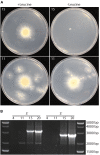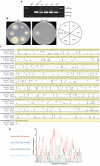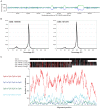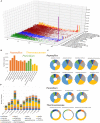Genomic and Genetic Insights Into a Cosmopolitan Fungus, Paecilomyces variotii (Eurotiales)
- PMID: 30619145
- PMCID: PMC6300479
- DOI: 10.3389/fmicb.2018.03058
Genomic and Genetic Insights Into a Cosmopolitan Fungus, Paecilomyces variotii (Eurotiales)
Abstract
Species in the genus Paecilomyces, a member of the fungal order Eurotiales, are ubiquitous in nature and impact a variety of human endeavors. Here, the biology of one common species, Paecilomyces variotii, was explored using genomics and functional genetics. Sequencing the genome of two isolates revealed key genome and gene features in this species. A striking feature of the genome was the two-part nature, featuring large stretches of DNA with normal GC content separated by AT-rich regions, a hallmark of many plant-pathogenic fungal genomes. These AT-rich regions appeared to have been mutated by repeat-induced point (RIP) mutations. We developed methods for genetic transformation of P. variotii, including forward and reverse genetics as well as crossing techniques. Using transformation and crossing, RIP activity was identified, demonstrating for the first time that RIP is an active process within the order Eurotiales. A consequence of RIP is likely reflected by a reduction in numbers of genes within gene families, such as in cell wall degradation, and reflected by growth limitations on P. variotii on diverse carbon sources. Furthermore, using these transformation tools we characterized a conserved protein containing a domain of unknown function (DUF1212) and discovered it is involved in pigmentation.
Keywords: Agrobacterium tumefaciens-mediated transformation; Byssochlamys spectabilis; DUF1212; Eurotiales; genome defense; leuA; mitochondrial membrane carrier.
Figures











Similar articles
-
Sexual reproduction as the cause of heat resistance in the food spoilage fungus Byssochlamys spectabilis (anamorph Paecilomyces variotii).Appl Environ Microbiol. 2008 Mar;74(5):1613-9. doi: 10.1128/AEM.01761-07. Epub 2008 Jan 11. Appl Environ Microbiol. 2008. PMID: 18192427 Free PMC article.
-
Characterization of the complete mitochondrial genome of Paecilomyces variotii and comparative evolutionary mitochondriomics of 36 fungi.Mol Biol Rep. 2024 Mar 6;51(1):390. doi: 10.1007/s11033-024-09330-x. Mol Biol Rep. 2024. PMID: 38446255
-
A Polyphasic Approach including Whole Genome Sequencing Reveals Paecilomyces paravariotii sp. nov. as a Cryptic Sister Species to P. variotii.J Fungi (Basel). 2023 Feb 22;9(3):285. doi: 10.3390/jof9030285. J Fungi (Basel). 2023. PMID: 36983453 Free PMC article.
-
The Chemical Diversity of the Ascomycete Fungus Paecilomyces variotii.Appl Biochem Biotechnol. 2015 Oct;177(4):781-91. doi: 10.1007/s12010-015-1783-z. Epub 2015 Aug 19. Appl Biochem Biotechnol. 2015. PMID: 26288080 Review.
-
Enzymes and bioproducts produced by the ascomycete fungus Paecilomyces variotii.J Appl Microbiol. 2015 Dec;119(6):1455-66. doi: 10.1111/jam.12934. Epub 2015 Sep 22. J Appl Microbiol. 2015. PMID: 26274842 Review.
Cited by
-
Molecular and biological characterization of a partitivirus from Paecilomyces variotii.J Gen Virol. 2023 Nov;104(11):001925. doi: 10.1099/jgv.0.001925. J Gen Virol. 2023. PMID: 38015047 Free PMC article.
-
Genome sequence and transcriptome profiles of pathogenic fungus Paecilomyces penicillatus reveal its interactions with edible fungus Morchella importuna.Comput Struct Biotechnol J. 2021 Apr 27;19:2607-2617. doi: 10.1016/j.csbj.2021.04.065. eCollection 2021. Comput Struct Biotechnol J. 2021. PMID: 34025947 Free PMC article.
-
Preservation stress resistance of melanin deficient conidia from Paecilomyces variotii and Penicillium roqueforti mutants generated via CRISPR/Cas9 genome editing.Fungal Biol Biotechnol. 2021 Apr 2;8(1):4. doi: 10.1186/s40694-021-00111-w. Fungal Biol Biotechnol. 2021. PMID: 33795004 Free PMC article.
-
The fungal gene cluster for biosynthesis of the antibacterial agent viriditoxin.Fungal Biol Biotechnol. 2019 Jul 1;6:2. doi: 10.1186/s40694-019-0072-y. eCollection 2019. Fungal Biol Biotechnol. 2019. PMID: 31304040 Free PMC article.
-
The most heat-resistant conidia observed to date are formed by distinct strains of Paecilomyces variotii.Environ Microbiol. 2020 Mar;22(3):986-999. doi: 10.1111/1462-2920.14791. Epub 2019 Oct 24. Environ Microbiol. 2020. PMID: 31444981 Free PMC article.
References
-
- Battestin V., Macedo G. A. (2007a). Purification and biochemical characterization of tannase from a newly isolated strain of Paecilomyces variotii. Food Biotechnol. 21 207–216. 10.1080/08905430701533588 - DOI
LinkOut - more resources
Full Text Sources
Molecular Biology Databases
Miscellaneous

